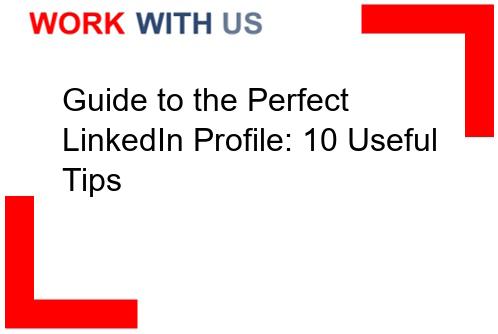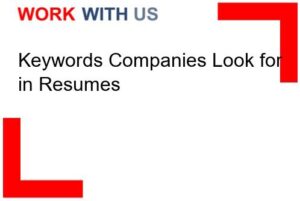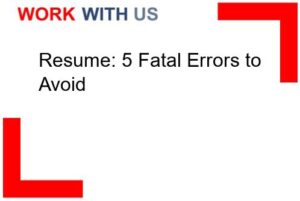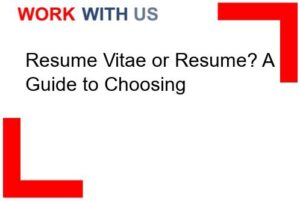In today’s digital age, having a strong online presence is essential for professional success. One platform that has become increasingly important for networking and career advancement is LinkedIn. With over 700 million users worldwide, LinkedIn is the go-to platform for professionals looking to connect with others in their industry, showcase their skills and experience, and find new job opportunities.
Creating a perfect LinkedIn profile is crucial for making a positive impression on potential employers, clients, and colleagues. A well-crafted profile can help you stand out from the crowd and attract the right opportunities. To help you optimize your LinkedIn profile, here are 10 useful tips to guide you towards creating a profile that will make a lasting impact.
Choose a Professional Profile Picture: Your profile picture is the first thing people see when they visit your profile, so it’s important to make a good impression. Choose a high-quality, professional-looking photo where you are dressed appropriately for your industry.
Write a Compelling Headline: Your headline is like your personal elevator pitch. Use this space to showcase your expertise, skills, and what sets you apart from others in your field. Keep it concise and engaging to grab the attention of visitors to your profile.
Craft a Strong Summary: Your summary is your opportunity to tell your story and highlight your achievements. Use this section to showcase your personality, passion for your work, and what you can offer to potential employers or clients.
Highlight Your Experience: Make sure to include detailed information about your work experience, including your job title, responsibilities, and accomplishments. Use bullet points to make it easy for visitors to scan through your profile.
Showcase Your Skills: LinkedIn allows you to list your skills and expertise on your profile. Make sure to include relevant skills that showcase your strengths and abilities. Endorsements from connections can also help validate your skills to others.
Connect with Others: Building a strong network is key to success on LinkedIn. Connect with colleagues, industry professionals, and others in your field to expand your network and increase your visibility.
Share Content: Sharing articles, blog posts, and other relevant content on your LinkedIn profile can help showcase your knowledge and expertise. It also shows that you are actively engaged in your industry.
Get Recommendations: Ask colleagues, supervisors, or clients to write recommendations for you on LinkedIn. These testimonials can help validate your skills and experience to others who visit your profile.
Join Groups: Joining LinkedIn groups related to your industry or interests can help you connect with like-minded professionals, share insights, and stay up-to-date on industry trends.
10. Stay Active: Regularly updating your profile, sharing content, and engaging with others on LinkedIn can help you stay top of mind with your network and increase your visibility on the platform.
By following these 10 tips, you can create a perfect LinkedIn profile that showcases your skills, experience, and personality in the best possible light. A strong LinkedIn profile can open doors to new opportunities, help you build valuable connections, and advance your career in meaningful ways. So take the time to optimize your profile and make the most of this powerful platform for professional networking and growth.
Crafting a compelling linkedin headline: strategies for standing out
In today’s competitive job market, having a strong LinkedIn headline is essential for standing out to potential employers and networking connections. Crafting a compelling LinkedIn headline requires strategic thinking and creativity to make a lasting impression. By following these strategies, professionals can increase their visibility and attract the right opportunities.
One effective strategy for creating a compelling LinkedIn headline is to highlight your unique skills and expertise. Instead of using generic terms like “experienced professional” or “skilled communicator,” focus on specific keywords that showcase your strengths. For example, a marketing specialist could use a headline like “Innovative Marketing Strategist Driving Brand Growth.” This not only conveys the individual’s expertise but also captures the attention of recruiters looking for those specific skills.
Another important aspect of a standout LinkedIn headline is to include relevant keywords that align with your industry and job goals. By incorporating industry-specific terms and buzzwords, professionals can increase their chances of appearing in search results and attracting the right audience. For instance, a software developer could use keywords like “Full-Stack Developer | Java | Python | Web Development” to target recruiters and companies seeking those skills.
In addition to highlighting skills and keywords, professionals can also leverage their unique value proposition in their LinkedIn headline. This involves showcasing what sets them apart from other candidates and why they are the best fit for a particular role. For example, a project manager could use a headline like “Results-Driven Project Manager Delivering On-Time, On-Budget Solutions.” By emphasizing their track record of success and value to employers, professionals can make a compelling case for why they should be considered for opportunities.
Furthermore, incorporating quantifiable achievements and metrics in a LinkedIn headline can help professionals stand out and demonstrate their impact. Instead of making vague claims, such as “results-oriented professional,” individuals can provide concrete examples of their accomplishments. For instance, a sales executive could use a headline like “Top Sales Performer Exceeding Revenue Targets by 30%.” This not only showcases their success but also provides evidence of their capabilities.
Moreover, professionals can also consider using a creative or attention-grabbing headline to differentiate themselves from the competition. By incorporating humor, a play on words, or a unique tagline, individuals can make a memorable impression on viewers. For example, a graphic designer could use a headline like “Design Ninja Transforming Ideas into Visual Masterpieces.” This not only showcases their creativity but also piques the curiosity of those who come across their profile.
Additionally, professionals should keep their LinkedIn headline concise and easy to read to ensure maximum impact. By using clear and straightforward language, individuals can quickly convey their value proposition and attract the attention of busy recruiters and hiring managers. Avoiding jargon and unnecessary words can help streamline the message and make it more effective.
Furthermore, professionals should regularly update their LinkedIn headline to reflect their current goals and achievements. By keeping the headline fresh and relevant, individuals can signal to viewers that they are actively engaged in their career and open to new opportunities. Whether it’s a recent promotion, a new certification, or a career milestone, updating the headline can help professionals stay visible and competitive in the job market.
In conclusion, crafting a compelling LinkedIn headline is a crucial step in standing out to potential employers and networking connections. By highlighting unique skills, incorporating relevant keywords, showcasing value proposition, including quantifiable achievements, using creativity, keeping it concise, and updating regularly, professionals can increase their visibility and attract the right opportunities. With these strategies in mind, individuals can create a standout LinkedIn headline that sets them apart from the competition and opens doors to new career possibilities.
Optimizing your linkedin summary: how to showcase your skills and experience
When it comes to optimizing your LinkedIn summary, it is important to showcase your skills and experience in a way that captures the attention of potential employers or connections. Your LinkedIn summary is one of the first things people see when they visit your profile, so it is crucial to make a strong impression. By highlighting your key skills and experiences, you can effectively communicate your value and expertise to others in your industry.
Crafting a Compelling Summary
One of the first steps in optimizing your LinkedIn summary is to craft a compelling introduction that grabs the reader’s attention. Start by including a brief overview of who you are and what you do, highlighting your key strengths and areas of expertise. Use this section to showcase your unique selling points and what sets you apart from others in your field. Remember to keep it concise and to the point, as you want to make a strong impression in a short amount of time.
Showcasing Your Skills and Experience
After your introduction, it is important to showcase your skills and experience in a way that is easy for others to understand. Use bullet points or short paragraphs to highlight your key accomplishments, projects, and areas of expertise. Be sure to include any relevant certifications, awards, or accolades that demonstrate your skills and qualifications. This section should give readers a clear understanding of what you bring to the table and why they should connect with you.
Using Keywords to Optimize Your Summary
To increase your visibility on LinkedIn, it is important to use keywords strategically throughout your summary. Think about the terms and phrases that are commonly used in your industry and incorporate them into your summary. This will help your profile show up in search results when recruiters or potential connections are looking for someone with your skills and experience. Be sure to include a mix of broad and specific keywords to ensure that your profile is easily discoverable by others.
Engaging Your Audience
In addition to showcasing your skills and experience, it is important to engage your audience in your LinkedIn summary. Share personal anecdotes, insights, or industry trends that demonstrate your passion for your work. This will help to humanize your profile and make you more relatable to others. Remember to keep your tone professional and positive, as you want to leave a lasting impression on those who visit your profile.
Seeking Recommendations and Endorsements
To further enhance your LinkedIn profile, consider seeking recommendations and endorsements from colleagues, clients, or mentors. These testimonials can provide social proof of your skills and expertise, helping to build credibility with those who view your profile. Be sure to reciprocate by endorsing others in your network, as this can help to strengthen your relationships and expand your professional network.
In conclusion, optimizing your LinkedIn summary is essential for showcasing your skills and experience to potential employers and connections. By crafting a compelling introduction, showcasing your key skills and experiences, using keywords strategically, engaging your audience, and seeking recommendations and endorsements, you can create a standout profile that attracts attention and opportunities in your industry. Remember to regularly update your profile with new accomplishments and experiences to keep it fresh and relevant. With a well-optimized LinkedIn summary, you can effectively communicate your value and expertise to others in your network.
Building a strong linkedin network: connecting with industry professionals
LinkedIn is a powerful tool for professionals looking to expand their network and connect with industry peers. Building a strong LinkedIn network can open up new opportunities, provide valuable insights, and help individuals establish themselves as thought leaders in their field.
One of the first steps to building a strong LinkedIn network is to optimize your profile. This means ensuring that your profile is complete, up-to-date, and showcases your skills and experience effectively. A professional headshot, a compelling headline, and a detailed summary can all help to make a strong first impression on potential connections.
Once your profile is in top shape, it’s time to start connecting with industry professionals. One way to do this is by joining LinkedIn groups related to your field. These groups can be a great way to engage with like-minded professionals, share insights, and stay up-to-date on industry trends. By actively participating in group discussions and offering valuable contributions, you can start to build relationships with other members.
Another effective way to connect with industry professionals on LinkedIn is by reaching out to individuals directly. When sending connection requests, it’s important to personalize your message and explain why you’re interested in connecting. Mentioning a shared interest, a mutual connection, or a recent accomplishment can help to make your request more compelling and increase the likelihood of it being accepted.
Networking on LinkedIn isn’t just about making connections – it’s also about nurturing those connections over time. This means engaging with your network regularly by liking, commenting on, and sharing their posts. By showing genuine interest in your connections’ activities and accomplishments, you can strengthen your relationships and demonstrate your value as a connection.
In addition to engaging with your existing connections, it’s also important to actively seek out new connections on LinkedIn. This can be done by using the platform’s search function to find professionals in your industry or by browsing through suggested connections based on your profile and activity. When sending connection requests to new contacts, be sure to include a personalized message that explains why you’re interested in connecting.
Building a strong LinkedIn network isn’t just about quantity – it’s also about quality. While it’s important to connect with a wide range of professionals in your industry, it’s equally important to focus on building meaningful relationships with key influencers and thought leaders. These individuals can provide valuable insights, mentorship, and opportunities for collaboration that can help to advance your career.
In addition to connecting with industry professionals, LinkedIn can also be a valuable tool for showcasing your expertise and establishing yourself as a thought leader in your field. One way to do this is by regularly sharing content on your profile that demonstrates your knowledge and insights. This could include articles, blog posts, videos, or infographics that provide value to your network and position you as an authority in your industry.
Another way to establish yourself as a thought leader on LinkedIn is by actively participating in discussions and sharing your opinions on industry topics. By engaging with others in a thoughtful and respectful manner, you can demonstrate your expertise, build credibility, and attract new connections who are interested in learning from you.
Building a strong LinkedIn network takes time and effort, but the benefits can be significant. By connecting with industry professionals, nurturing relationships, and establishing yourself as a thought leader, you can expand your network, access new opportunities, and position yourself for success in your career. So, take the time to optimize your profile, reach out to new connections, and engage with your network – your efforts will pay off in the long run.
Leveraging linkedin recommendations and endorsements: establishing credibility and trust
LinkedIn recommendations and endorsements are powerful tools that professionals can use to establish credibility and trust within their network. By showcasing positive feedback from colleagues, clients, and supervisors, individuals can build a strong online reputation that can help them stand out in a competitive job market. Recommendations provide detailed testimonials of a person’s skills and work ethic, while endorsements allow connections to validate specific skills listed on a profile. Together, these features can help professionals showcase their expertise and build a strong personal brand on LinkedIn.
Building Credibility Through Recommendations
One of the key benefits of LinkedIn recommendations is that they provide a more in-depth look at a person’s professional abilities. Unlike endorsements, which are quick validations of skills, recommendations offer detailed testimonials from colleagues or clients who have worked closely with the individual. These testimonials can provide valuable insights into a person’s work ethic, communication skills, and overall performance. By collecting a diverse range of recommendations from different sources, professionals can showcase their strengths and expertise in a compelling way.
Establishing Trust Through Endorsements
Endorsements, on the other hand, are a quick and easy way for connections to validate a person’s skills. While endorsements may not carry the same weight as recommendations, they can still play a valuable role in establishing credibility on LinkedIn. When a person has a high number of endorsements for a particular skill, it can signal to potential employers or clients that they are proficient in that area. By actively seeking endorsements from connections who can vouch for their skills, professionals can build trust and credibility within their network.
Maximizing the Impact of Recommendations and Endorsements
To make the most of LinkedIn recommendations and endorsements, professionals should be proactive in seeking feedback from colleagues and clients. They can reach out to past supervisors, coworkers, or clients and request recommendations that highlight their key strengths and accomplishments. Additionally, individuals can strategically list their skills on their profile and ask connections to endorse them for those skills. By actively curating their recommendations and endorsements, professionals can create a strong online presence that showcases their expertise and credibility.
Showcasing Social Proof
One of the key benefits of LinkedIn recommendations and endorsements is that they provide social proof of a person’s skills and abilities. When potential employers or clients see positive feedback from others in a person’s network, it can help to validate their expertise and build trust. By showcasing a strong collection of recommendations and endorsements on their profile, professionals can demonstrate to others that they are highly skilled and competent in their field. This social proof can be a powerful tool in building credibility and trust within the LinkedIn community.
Building a Strong Personal Brand
In addition to establishing credibility and trust, LinkedIn recommendations and endorsements can also help professionals build a strong personal brand. By curating a collection of positive feedback from colleagues and clients, individuals can create a compelling narrative about their skills and accomplishments. This can help them differentiate themselves from others in their field and stand out to potential employers or clients. By leveraging recommendations and endorsements to showcase their expertise and build a strong personal brand, professionals can position themselves as leaders in their industry and attract new opportunities.



